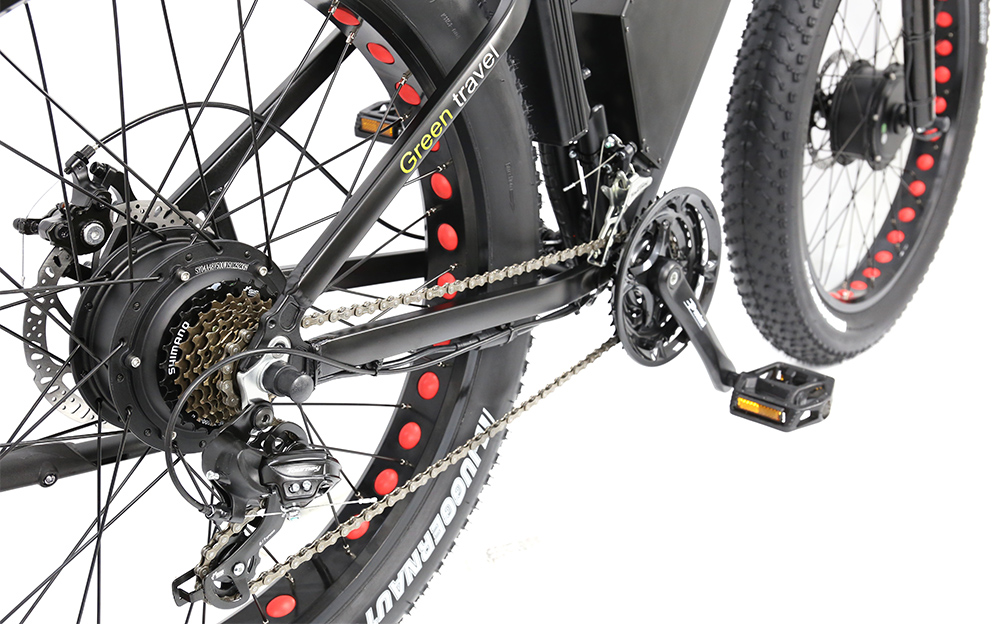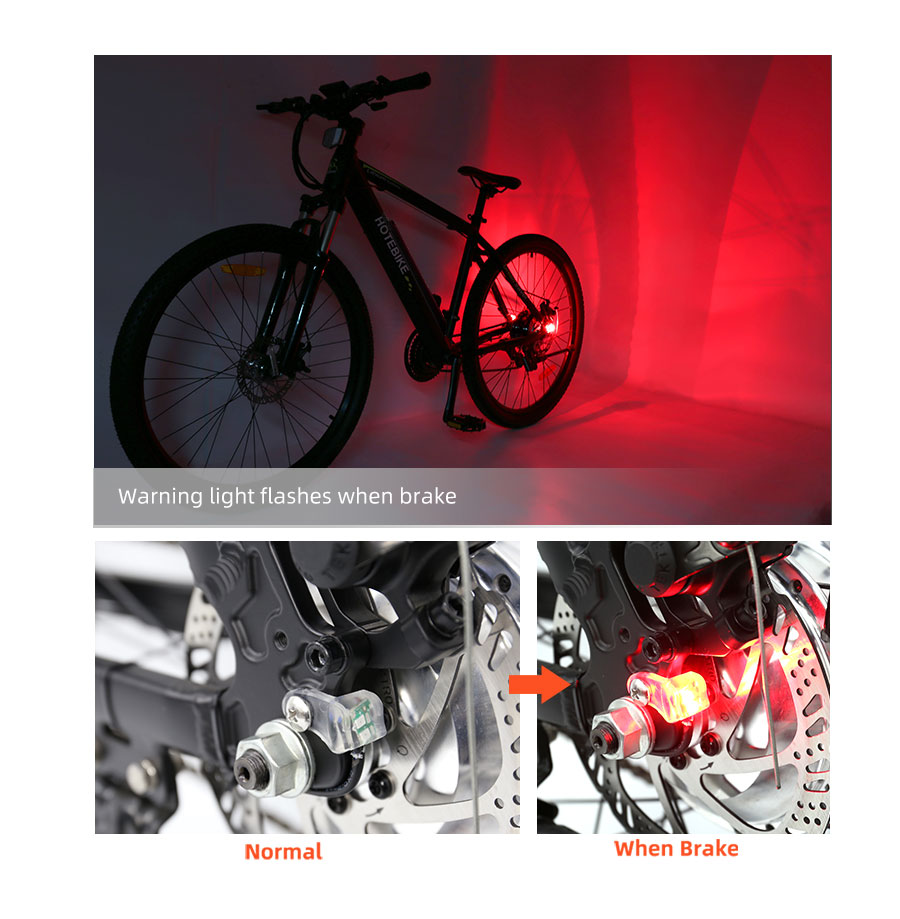What is the safest way to brake while riding?
If you want to park your bike in the safest possible way, you have to pay special attention to how you use the front and rear brakes.
The common belief is that the front and rear brakes should be used at the same time. This is suitable for beginners who have not mastered the braking skills. But if you only stay at this stage, you will never be able to stop the bike in the shortest distance and the safest way as riders who only learn to use the front brake.
Maximum deceleration-emergency brake
The quickest way to stop any bicycle with a normal front and rear wheel span is to apply a lot of force on the front brake so that the rear wheel of the bicycle is just about to lift off the ground. At this time, the rear wheel has no pressure on the ground and cannot provide braking force.
Will it turn forward from the top of the handlebar?
If the ground is slippery or the front wheel has a puncture, then only the rear wheel can be used. But on dry asphalt/concrete roads, using only the front brake will provide maximum braking power. This is true both in theory and in practice. If you take the time to learn to use the front brake correctly, then you will become a safe driver.
Many people are afraid to use the front brake, worrying about turning forward from above the handlebars. Front flips do happen, but they mainly happen to people who have not learned how to use the front brake.
Riders who only use the rear brake will not have problems under normal circumstances. But in an emergency, in a panic, in order to stop quickly, the driver will both squeeze the rear brake and the front brake that is not familiar at all, resulting in the classic “handle overturning”.
Jobst Brandt has a fairly credible theory. He believes that the typical “handle overturned forward” is not caused by excessive front brake force, but because the rider did not use his arms against the front brake to counter the body’s inertia when the front brake was used vigorously: the bicycle stopped. But the rider’s body didn’t stop until the rider’s body hit the front handlebar, causing the bike to roll forward. (Translator’s Note: At this time, the person’s center of gravity is already very close to the front wheel, and it is easy to turn forward).
If only the rear brake is used, the above situation will not happen. Because once the rear wheel starts to tilt, the braking force will be reduced accordingly. The problem is that compared to using only the front wheel to brake, the former takes twice as long to stop. So for fast drivers, it is not safe to use only the rear wheels. In order to avoid turning forward, it is very important to use your arms to hold your body against it. Good braking technique requires moving the body as far back as possible and moving the center of gravity as far back as possible. Do this regardless of whether you use only the front brake, only the rear brake, or both front and rear brakes. Using the front and rear brakes at the same time may cause tail swinging. When the rear wheel starts to slide and the front wheel still has braking force, the rear of the bicycle will swing forward because the front wheel braking force is greater than the rear wheel braking force. Once the rear wheel starts to slide, it can swing forward or sideways.
Rear wheel slippage (drift) wears down the rear tire very quickly. If you stop a 50 km/h bicycle with the rear wheel locked, you can grind the tire to the braid in a single pass.
Learn to use the front brake
The maximum braking force is when a lot of force is applied to the front brake, so that the rear wheel of the bicycle is just about to lift off the ground. At this time, a little bit of rear brake will cause the rear wheel to drift.
If you are using a normal bicycle, the best way to learn to use the front brake is to find a safe place and use the front and rear brakes at the same time, but mainly use the front brake. Keep pedaling so that you can feel the rear wheels start to drift from your legs. “Pinch” instead of “grab” the brake lever so that you can feel it. Practice getting harder and harder brakes, and realize the feeling that the rear wheels are about to lift up when the brakes are slammed.
Every time you ride an unfamiliar bicycle, you have to experiment like this. Different cars have different braking sensitivity, so you know the braking feeling of the car.
Once you can use the front brake with confidence, practice relaxing the brake to restore control of the bike until it becomes an automatic conditioned reflex. Reduce the vehicle speed and brake hard until the rear wheel is about to tilt, then release the brake. Don’t forget to wear a helmet.
Some drivers like to fly. When the front brake is applied hard on the dead fly, the transmission system will clearly feed back the grip of the rear wheel to the driver. (This is why it is better to fly to death in winter). If you ride a dead speed bike with only the front brake, your legs will tell you exactly when the maximum braking force of the front brake is reached. Once you learn this on a dead speed bike, you can use the front brake well on any bike.
When to use the rear brake
The cyclist only uses the front brake 95% of the time, but in some cases it is better to use the rear brake.
Slippery road. On dry asphalt/concrete roads, unless turning, it is basically impossible to use the brakes to slip the front wheels. But on slippery roads, this is possible. Once the front wheel slips, wrestling is inevitable. So if the ground is slippery, it is better to use the rear brake.
Bumpy road. On bumpy roads, the wheels will leave the ground instantly. In this case, do not use the front brake. If you encounter obstacles, using the front brake will make it difficult for the bicycle to pass the obstacles. If the front brake is used when the front wheel is off the ground, the wheels will stop spinning in the air. The consequences of landing with a stalled wheel can be serious.
The front tire is flat. If the front tire bursts or suddenly loses air, use the rear brake to stop the car. Using the brake when the tire is flat may cause the tire to fall off and fall.
The brake cable is broken, or other failures of the front brake.
When to use the front and rear brakes at the same time
Under normal circumstances, it is not recommended to use the front and rear brakes at the same time, but there are always exceptions:
If the front brake braking force is not enough to make the rear wheel tilt up, the rear wheel can also provide braking at this time. But it is best to repair the front brake. The general rim brake loses a lot of braking force when the rim is wet. At this time, using the front and rear brakes at the same time can reduce the braking distance.
If the front brake is astringent or has abnormal noises and cannot be smoothly controlled, the front brake must be used sparingly. It is still necessary to fix the front brake as soon as possible.
Straight and long downhill, the hand that has been squeezing the front brake will be very tired, and it may overheat the front wheel and cause a flat tire. At this time, it is best to use the front and rear brakes in turn. Use a point brake to distribute the heat generated by the brakes on the two rims and dissipate them, so as to avoid the accumulation of heat and affect the tires. When you need to decelerate quickly, use the front brake.
When cornering, the grip has to be both braking and cornering. Using the front and rear brakes at the same time can reduce the possibility of wheels slipping. The harder the corner, the lighter the brakes. So control your speed before entering the turn. Don’t use the brakes when cornering is very urgent.
For bicycles with very long or low bodies, such as tandem or reclining bicycles, their geometry makes it impossible to tilt the rear wheels. The front and rear brakes of this car can provide maximum braking force at the same time.
Note for riding a tandem bicycle: If there is no one in the back bike seat or a child is sitting, the rear brake is basically useless. At this time, if the front and rear brakes are used at the same time, the risk of tail swinging becomes very great.
If you want to know more about electric bikes, please click:https://www.hotebike.com/
LEAVE US A MESSAGE
 hotebike
hotebike

